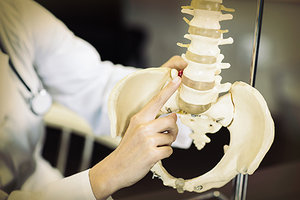For chiropractic to compete in the spinal marketplace, we must be considered peers with our medical counterparts in spine care. Moreover, in the medical-legal community, we will not be considered a valuable solution in the courts without being experts. The most "basic" element of collaboration in terms of being a peer and an expert is terminology.
Our profession has worked tirelessly to ensure that we get recognition in the radiological community to be considered a peer. The American Chiropractic College of Radiology (ACCR) and the American Chiropractic Board of Radiology are at the highest level for those who want to practice as a reading radiologist.
 There is a Qualification in MRI Interpretation Review for practitioners who want to ensure the interpretation from the radiologist is accurate, recognized by chiropractic academia. The Fellowship in Primary Spine Care is certified by medical and chiropractic academia, with a strong focus on MRI interpretation to further ensure the interpretations are correct.
There is a Qualification in MRI Interpretation Review for practitioners who want to ensure the interpretation from the radiologist is accurate, recognized by chiropractic academia. The Fellowship in Primary Spine Care is certified by medical and chiropractic academia, with a strong focus on MRI interpretation to further ensure the interpretations are correct.
No matter where you as a practitioner choose to participate, it is critical to use "contemporary, evidence-based nomenclature," because the lack thereof will not only hurt your reputation, but also injure the chiropractic profession. Terms such as "slipped / prolapsed disc" and other colloquial or noncontemporary, evidence-based nomenclature, when used in collaborative or expert relationships, will destroy relationships.
When considering terminology, "Lumbar Disc Nomenclature: Version 2.0: Recommendations of the Combined Task Forces of the North American Spine Society, the American Society of Spine Radiology, and the American Society of Neuroradiology"(2014)by Fardon, et al.,1 has been the guiding contemporary document used in medical and chiropractic academia. This paper has also been cited by 454 other indexed, peer-reviewed articles, making it a well-recognized authority within the scientific community.
Terminology 101: Use It Correctly
The following are examples of terminology as reported by Fardon, et al.:1
Herniation: is broadly defined as a localized or focal displacement of disc material beyond the limits of the intervertebral space. The disc material may be the nucleus, cartilage, fragmented apophyseal bone, annular tissue, or any combination thereof. The disc space is defined as craniad and caudad by the vertebral body endplates and, peripherally, by the outer edges of the vertebral ring apophyses, exclusive of osteophytes.
Herniated Discs may be classified as protrusion or extrusion based on the shape of the displaced material.
Protrusion is present if the greatest distance between the edges of the disc material presenting outside the disc space is less than the distance between the edges of the base of that disc material extending outside the disc space. The base is defined as the width of disc material at the outer margin of the disc space of origin, where disc material displaced beyond the disc space is continuous with the disc material within the disc space.
Extrusion is present when, in at least one plane, any one distance between the edges of the disc material beyond the disc space is greater than the distance between the edges of the base of the disc material beyond the disc space or when no continuity exists between the disc material beyond the disc space and that within the disc space. The latter form of extrusion is best specified or subclassified as equestration if the displaced disc material has completely lost continuity with the parent disc. The term migration may be used to signify displacement of disc material away from the site of extrusion. Herniated discs in the craniocaudal (vertical) direction through a gap in the vertebral body endplate are referred to as intravertebral herniations (Schmorl nodes).
Bulging Disc:
- A disc in which the contour of the outer annulus extends, or appears to extend, in the horizontal (axial) plane beyond the edges of the disc space, usually greater than 25% (90°) of the circumference of the disc and usually less than 3 mm beyond the edges of the vertebral body apophysis.
- (Nonstandard) A disc in which the outer margin extends over a broad base beyond the edges of the disc space.
- (Nonstandard) Mild, diffuse, smooth displacement of disc.
- (Nonstandard) Any disc displacement at the discal level.
Note: bulging is an observation of the contour of the outer disc and is not a specific diagnosis.
Take the Next Step
The above definitions give a basic understanding of disc pathology to ensure an accurate conversation with a collaborating physician. Still, they fail to make any doctor an expert without formal training (for example, see earlier suggestions regarding radiological qualification / fellowship). MRI spine interpretation is one arena that will help catapult the chiropractic profession as primary care providers or the first option for spine management. This is where we can start to break that 7-10 percent utilization cycle.
Reference
- Fardon, DF, et al. Lumbar disc nomenclature: version 2.0: recommendations of the combined task forces of the North American Spine Society, the American Society of Spine Radiology and the American Society of Neuroradiology. Spine J, 2014;14(11):2525-2545.
Dr. Mark Studin is an adjunct associate professor at the University of Bridgeport School for Chiropractic, teaching advanced imaging and triaging chronic and acute patients; and an adjunct postdoctoral professor at Cleveland University-Kansas City College of Chiropractic. He is also a clinical instructor for the State University of New York at Buffalo, Jacobs School of Medicine and Biomedical Sciences, Office of Continuing Medical Education. Dr. Studin consults for doctors of chiropractic, medical primary care providers and specialists, and teaching hospitals nationally. He can be reached at
or 631-786-4253.




